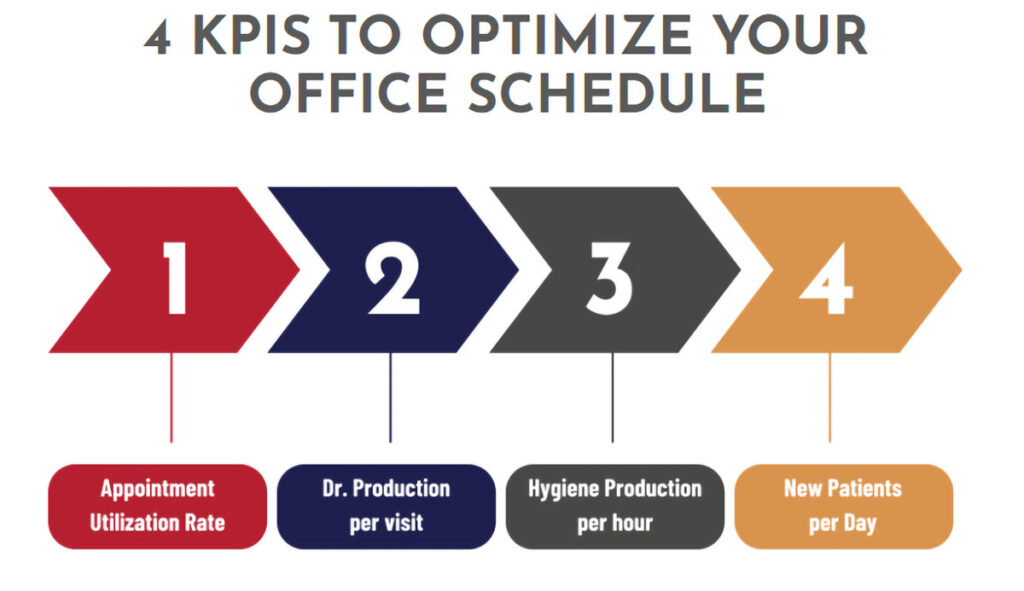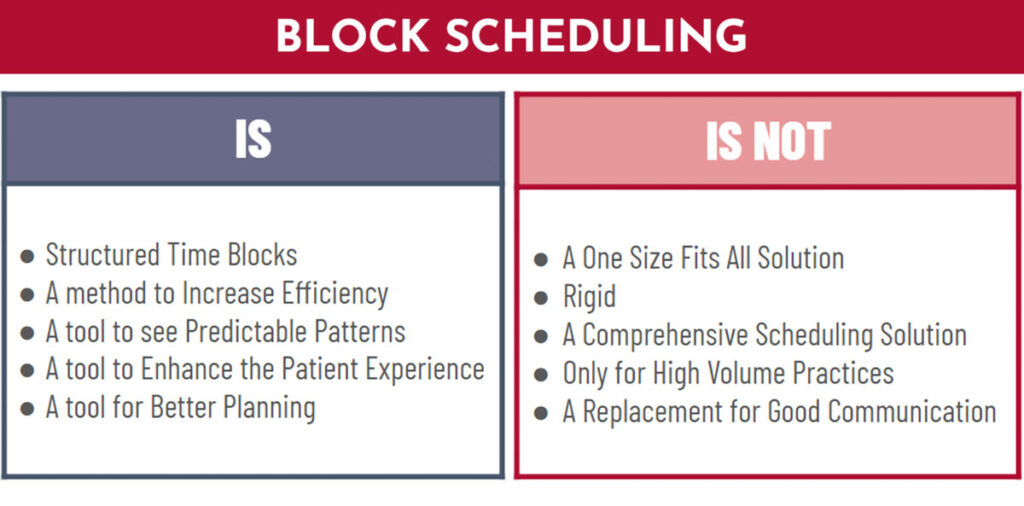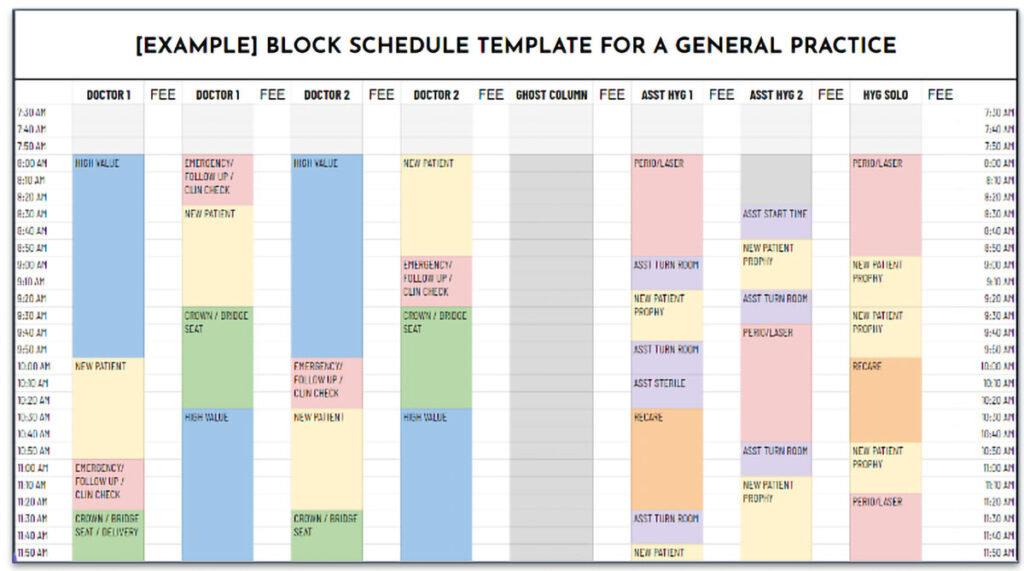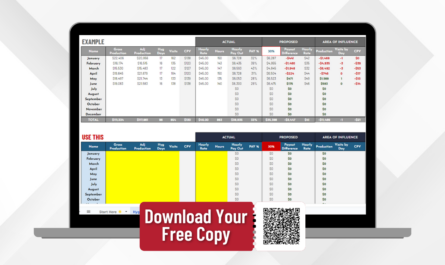The quality of your scheduling process will directly impact your ability to drive a profit, for better or worse.
What does your daily schedule look like? Do you have a full day packed with patients in your chair, or are there open spots where you could be making money? Building a schedule is like piecing together an overly complicated puzzle, without a picture to help guide the way. Without knowing what it’s supposed to look like, it can be difficult to build success quickly.
So, how do you know that your current scheduling process isn’t working? There are a number of symptoms that you can use to diagnose a scheduling problem. Whether your appointment availability is not aligned to the goals of your practice, your scheduling process is inefficient for production, or you just have too many time slots open on your schedule.
Whatever the reason, it’s important to understand how your scheduling process can be used as a profitability lever for your organization.
How your office schedule might impact your profit
There are three key areas where office schedule challenges could be directly impacting the profit of your organization:
- Your cost of labor is high compared to the revenue you are producing.
- Your day falls apart when patients don’t show up for their appointments.
- You don’t have the correct systems in place for hygiene reappointments.
Each of these areas is invaluable to the operation of your dental office. Dental organizations live and die by their scheduling processes, so it’s critical for this to be done the right way. It’s also important to remember that there is no “one size fits all” solution for everyone – each dental organization is going to need to find the areas where their scheduling processes do and don’t work, and then find the appropriate solution to move forward.

Office schedule KPIs you can track
Key performance indicators are a great way to measure activities and gain insights on certain elements of your business performance. Here are four main KPIs that you can track to determine how effective your scheduling processes are and where you might need to make some improvements:
- Appointment utilization rate
- Doctor production per visit
- Hygiene production per hour
- New patients per day
The appointment utilization rate is the percentage of scheduled appointment slots that are actually utilized by patients. This helps you to understand how effectively you’re using your time. To find your average utilization rate, you can divide the number of patients by the number of available appointment slots in your schedule and multiply that by 100 to get an accurate percentage.
Doctor production per visit is the total revenue generated by a dentist for each patient visit. This helps with revenue insight by assessing the financial performance and efficiency of each doctor in your practice. If you’re paying doctors a certain amount per day, this will tell you if your practice is financially sound – production needs to be at a certain level in order to pay dentists and associates, while staying within 30% of the dentist’s pay.
Hygiene production per hour measures the amount of production generated by hygienists for each hour they work. This helps to identify how effectively the hygiene schedule is being utilized. It can also reveal whether there are opportunities to book more appointments or if there are gaps that need to be filled. It’s important to make sure that your hygienists are producing what they need to so that they can be paid, while ensuring that profitability is in alignment.
The number of new patients visits per day literally measures the number of new patients that your office sees each day. This helps to better understand demand patterns and can help you to adjust scheduling blocks to ensure sufficient slots are available and monthly new patient goals are met.
These KPIs are fairly simple, but can provide a lot of essential and invaluable data about how your team and your organization are performing and where they can improve.

Is block scheduling a solution for you?
Block scheduling is a series of structured time blocks that could help your office to increase efficiency, see predictable patterns, enhance the patient experience, and plan better. This is a flexible approach that is designed to help your practice organize and streamline your scheduling procedures.
The first step to set up a block scheduling is to begin with the end in mind. Determine the daily production goal in terms of revenue, procedures, and number of patients. This should be specific, measurable, and realistic, based on your practice’s historical data and future projections. Analyze your existing schedule to understand how time is currently allocated for different types of appointments and procedures, and then identify the times when your practice is busiest or when patient demand is highest.
For the second step, you need to determine the different time blocks that you’re working with. Take the time to list out the types of procedures your practice handles and decide how long each block should be based on the average time historically required for different procedures, as well as the time difference between specific providers. From there, you can group similar procedures together to reduce downtime and increase the number of procedures you can complete in a day.
At this point, you’ll need to create a template to map everything out. Design your schedule template with time blocks dedicated to different types of procedures. Arrange the high-production procedures during peak appointment times, or when the patient demand is highest. Make sure to allow for buffer times between appointments to accommodate for unexpected delays and ensure smooth transitions between procedures.

Implementing block scheduling
Once you have set up a block scheduling template, it’s time to start implementing it for your practice. Present the plan to your team to ensure that everyone is aligned to the same goals and vision, while also helping them to understand their roles in the implementation process. Everyone has a role to play!
Partner with your office manager and operations leader to adapt the templates to fit the specific and dynamic needs of your organization. Each organization has its own challenges, and each location within those organizations have their own separate challenges. Consulting with your team will give you different perspectives on how to navigate those challenges – each perspective is critical to forming the shape of your block scheduling process going forward.
From there, you need to monitor and refine. Review the data regularly and make adjustments as necessary to optimize the performance. Track your organization’s performance through the necessary KPIs to ensure that goals are met, while also monitoring the overall patient experience. Gather feedback from your patients and your team to get a better idea of how effective block scheduling is for everyone involved.





